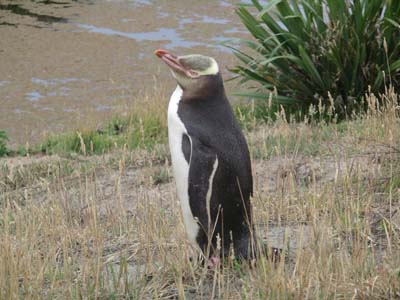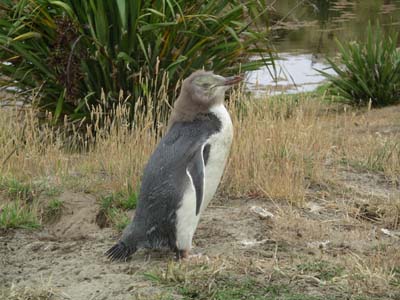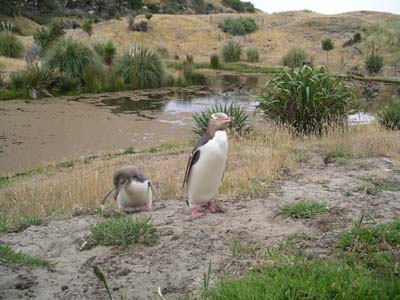DAVID'S DOWNLOADS
David's Download: Yellow Eyed Penguins

This week we visited the Yellow Eyed Penguin Conservation Reserve, where we saw one of the rarest and most spectacular penguins on earth: the Hoiho. The Hoiho Penguin, or Yellow Eyed Penguin, is native to New Zealand and can only be seen in this country.
The Penguin Place (conservation reserve) had an extremely unique set-up. Down on the beach in the middle of the penguin's territory, they had a series of waist deep trenches and hides, through which you could easily observe the penguins in close quarters. The beach could easily be mistaken for a World War 1 battle field, with intricate trenches camouflaged with bushes and dried leaves. Walking through these channels was really cool. I felt like a soldier jogging through dugouts trying to follow the Germans, and guessing what their next move would be! You would think at first that the penguins would still be frightened if they saw ten or more faces peering out at them wherever they went. This method of hides is effective because the penguins can only see your faces! They immediately assume you are smaller than they are, and are not disturbed. I loved being able to see these rare penguins up close in their natural habitat, without alarming them.
 The
Yellow Eyed Penguin is an extremely rare and protected bird. They are very
independent and are particularly territorial. They are also one of the largest
penguins on earth, and can grow up to 2 feet tall! Their yellow eyes, snow
white chests, and black backs are magnificent. I especially like the hair
on their head which looks as if it is dyed gold with slick black streaks.
Seeing the penguins hop out of the water, shake off, and wobble back to their
chicks created an unforgettable memory for me. They were one of the coolest
animals I have ever seen! The penguins can live for up to 20-25 years, and
can raise over 20 chicks in their life. They breed for 12 weeks and can have
up to two chicks any given breeding season. The parents take turns incubating
the eggs and regurgitating their food to feed the chicks. The penguins also
molt every year for four months. During this stage, they lose all their feathers
and grow new ones. They cannot fish during this time because their feathers
are not yet waterproof. They must get extremely fat before molting so they
do not die of starvation while molting.
The
Yellow Eyed Penguin is an extremely rare and protected bird. They are very
independent and are particularly territorial. They are also one of the largest
penguins on earth, and can grow up to 2 feet tall! Their yellow eyes, snow
white chests, and black backs are magnificent. I especially like the hair
on their head which looks as if it is dyed gold with slick black streaks.
Seeing the penguins hop out of the water, shake off, and wobble back to their
chicks created an unforgettable memory for me. They were one of the coolest
animals I have ever seen! The penguins can live for up to 20-25 years, and
can raise over 20 chicks in their life. They breed for 12 weeks and can have
up to two chicks any given breeding season. The parents take turns incubating
the eggs and regurgitating their food to feed the chicks. The penguins also
molt every year for four months. During this stage, they lose all their feathers
and grow new ones. They cannot fish during this time because their feathers
are not yet waterproof. They must get extremely fat before molting so they
do not die of starvation while molting. 
There are extreme measures being taken at the moment to protect and preserve these birds. There are only 4,000 left, but have been slowly building up their numbers. Almost every breeding site has been created into a reserve, with access permitted only with a guide. Hopefully these birds will soon become common again, and will no longer have to worry about extinction.
One of the things I found to be both amazing and comical was how the guides treated the colony like a human suburb! Each penguin had a name and property! For example, one of the penguins we saw was named Paul. The guides constructed a life summary of Paul, and told us what he had been doing lately. Paul is a huge property owner and owns a whole pond and hill. If any penguin swims in his pond, he gets a beating. We heard that Paul had been a bachelor for a number of years, flirting with many women, until a female named Jill came along. Jill had been mating with Jack for eight years, until Jack passed away at sea. Jill and Paul have now been mating for a couple years. We also heard that recently a male named Tarzan had advanced on Jill when Paul was out fishing. Jill beat him up, refusing to cheat on Paul. The next day Tarzan came again, only to find Paul and Jill were there. Tarzan supposedly got pinned to the ground by both of them, and got bit, slapped, and pecked. Tarzan never got near Jill again. The guide also told us stories of other big fights, social events, and love affairs. We all thought this was pretty cool!
